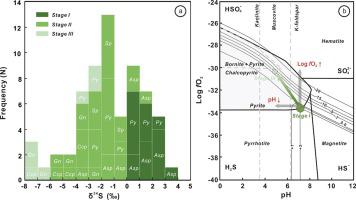当前位置:
X-MOL 学术
›
Ore Geol. Rev.
›
论文详情
Our official English website, www.x-mol.net, welcomes your feedback! (Note: you will need to create a separate account there.)
Distal relationship of the Taihexian Pb-Zn-(Au) deposit to the Dengfuxian magmatic-hydrothermal system, South China: constraints from mineralogy, fluid inclusion, H-O-Pb and in situ S isotopes
Ore Geology Reviews ( IF 3.3 ) Pub Date : 2020-12-01 , DOI: 10.1016/j.oregeorev.2020.103826 Yi-Qu Xiong , Yong-Jun Shao , Shao-Yong Jiang , Kui-Dong Zhao , Qi Yan
Ore Geology Reviews ( IF 3.3 ) Pub Date : 2020-12-01 , DOI: 10.1016/j.oregeorev.2020.103826 Yi-Qu Xiong , Yong-Jun Shao , Shao-Yong Jiang , Kui-Dong Zhao , Qi Yan

|
Abstract The Taihexian Pb-Zn(-Au) vein-style deposit is located in the well-preserved Dengfuxian magmatic-hydrothermal W-(Sn) ore field, South China. The deposit can be divided into three mineralization stages: I) pyrite–arsenopyrite–chalcopyrite ± gold–tourmaline–quartz stage, II) pyrite–arsenopyrite–chalcopyrite–sphalerite–galena–quartz stage, and III) pyrite–galena–sphalerite–quartz–calcite–fluorite stage. Liquid-rich NaCl-aqueous inclusions, vapor-rich NaCl-aqueous inclusions, CO2-rich inclusions, and three-phase CO2-H2O inclusions occur in quartz and calcite of the ore veins at Taihexian. The ore veins of the three stages formed at around 310 °C, 210 °C and 170 °C, respectively, precipitated from H2O-NaCl-±CO2 ± CH4 fluids with salinities averaging around 5 wt% NaCl eq. The ore-forming mechanisms include fluid immiscibility (a potential trigger for metal precipitation from hydrothermal fluids) during stage I, fluid mixing during stage II, and cooling during stage III. Oxygen (δ18Ofluid = −1.5–6.9‰) and hydrogen (δDfluid = −61 to −53‰) isotopes suggest that the ore-forming fluids originated from a mixture of magmatic water with ground water and/or meteoric water. Sulfur isotopes (δ34S = −7.8–3.1‰) suggest a magmatic origin for sulfur in stages I and II, and then possibly mixing with sulfur from sedimentary rocks in stage III. Lead isotopes (206Pb/204Pb = 18.05–18.65, 207Pb/204Pb = 15.53–15.75, 208Pb/204Pb = 37.91–38.88) indicate that ore metals originated mainly from the upper crust with minor mantle contributions. Comparing arsenopyrite, sulfur isotope and fluid inclusion geothermometers, it is estimated that the ore formation pressure was about 58–120 MPa, corresponding to a depth of approximately 2.2–4.5 km. Taihexian appears to form part of a regional magmatic-hydrothermal system centered on the Dengfuxian pluton.
更新日期:2020-12-01


























 京公网安备 11010802027423号
京公网安备 11010802027423号